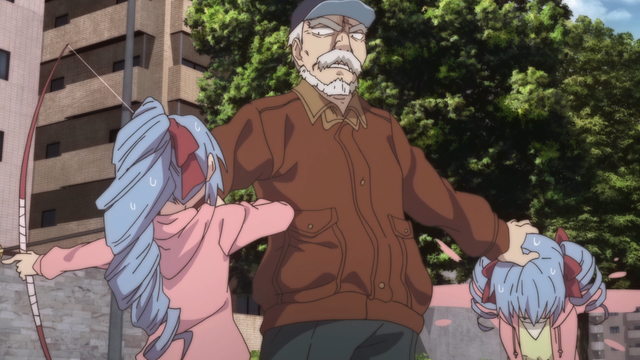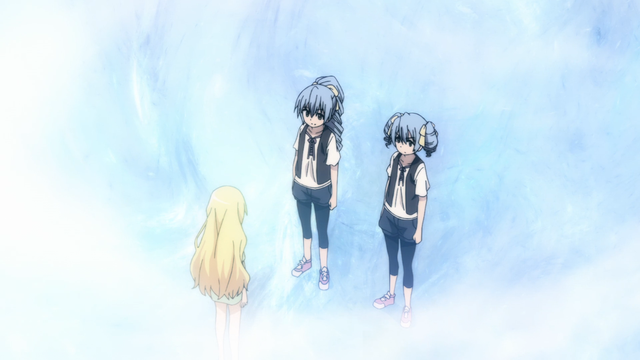Alice & Zoroku is a familiar formula in the world of anime. A girl escapes from an experimental facility and attempts to achieve the same life of normalcy most of us take for granted while avoiding the pursuit of her captors. We’ve seen this narrative before in series like Elfen Lied and Brynhildr in the Darkness. While the premise itself presents a great opportunity for commentary, Alice & Zoroku is unique for making such a concerted effort of diving into the philosophical questions raised by this dynamic and providing its own answer to these questions rather than leave them open-ended. Sana's nature is the subject of conflicting philosophies in Alice & Zoroku and how characters choose to define her inevitably defines their own role in the story.

Regardless of what Sana is now, her origins are a far cry from human. Described as something more like an object than an organic being discovered beneath the ground of what is now the research facility designed solely to study her. Whatever she was, she possesses the power to seemly create or change anything and her original form had the ability to absorb information from the world around it, including human thought. Residing in a cave, it makes sense she would take the form of something resembling a stone. After humans began studying her, she eventually took on their appearance. As she absorbed their thoughts, she too began to think. Sana described her own awareness spontaneously rising out of nothing, one day she was simply present within herself where she hadn’t been before.

Sana’s power is regarded with an almost religious reverence by those studying her, which isn’t a difficult stretch. Beneath the facility now rests an alternate world of Sana’s creation, populated by only the things she likes and which destroys anything she doesn't save only for humans. Although she lacks omniscience, Sana’s power does begin to edge into the realm of omnipotence. Despite this, no one has treated her with anything approaching worship. Zoroku, Sanae, and Naito’s group have acted toward Sana as they would any child her age while Minnie C and the residents of the facility have acted only to exploit Sana. This difference in treatment arises out of their central conflict regarding how they define Sana and others who possess the Dreams of Alice.

After kidnapping Sana to bring her back to the facility, Minnie C commits acts that are hard to see as anything but monstrous. She deems Sana’s own desires and feelings as irrelevant, a false reflection of actual human thought and emotion created by a simulacrum responding to and imitating its environment. She subjects Sana to physical and psychological torture while excusing her own actions by dehumanizing her. Minnie C’s status as a villain is cemented in the lurid detail with which it depicts these inhuman acts as well as the pain and fear Sana is clearly suffering from even as Minnie C rejects its authenticity.

There are some obvious flaws in Minnie C’s perspective. The same fear which Minnie C rejects that Sana is actually is experiencing is the same emotion she is relying on to keep Sana compliant. Her own motivation, driven by grief over the loss of her husband, is deeply human but has resulted in a monomaniacal obsession toward which no act is too distasteful. Despite this claim, she repeatedly justifies her actions by dehumanizing Sana, claiming the conditions under which she was created don't qualify her as a human while remaining intent on using that very same power to bring back her husband. Essnetially she wishes to believe the power Sana controls is capable of creating authentic life, but it's inconvenient to her goals to believe that authenticity applies to Sana.

We see the same theme play itself among Zoroku’s camp as they are faced with what do with a herd of piglets Sana accidentally created. Confronted with the proposition of making them disappear again, Sana is reluctant. If she makes them disappear, where do they go? Would that be the same as killing them? As a living creature created through the same power, she obviously considers their life to be just as real as her own. Shizuku agrees and makes arrangements for them to go to a government farm to be studied humanely and live out peaceful lives. In doing so, she legitimizes Sana’s own existence, treating the creatures created through her power with respect and acknowledging Sana's agency.

When confronted with the scene of Minnie C torturing Sana, it’s a matter of course for Zoroku to label Minnie C is the true monster. He makes no attempt to rationalize Sana’s natured based on how she came to be, but defines her simply through her actions. He witnessed her experience human emotions and the same biological necessities as humans. If it looks like a duck and quacks like a duck, then it must be a duck. Whatever means individuals use to attempt to define Sana, attempting to label her as anything other than a little girl is inevitably used to excuse cruelty and justify exploitation.

As humans disagree on ethics, the world is changing around them. We’re presented with a picture of an undefinable being approaching humanity as humanity rises to meet it. Every change Sana has undergone to become more humanlike has, in some way, resulted in a limitation. Taking a human form meant taking on its vulnerabilities and biological needs. Her awareness rose from a primal desire that needed to be fulfilled, hunger. Although she was aware, she possessed no sense of self until she encountered the twins whose thoughts she could not read. In recognizing the boundary between her and another she reached an awareness of her own individuality. Sana became a singular being and was then forced to learn language as a means of communication.

As Sana becomes more defined by her limitations, humans are beginning to break free of their own by developing her ability to create. If there is a point somewhere between Sana and Shizuku, or between the Sana we see now and what she used to be, that represents the boundary of humanity, it is yet to be defined. If anything, it’s shown to be unimportant. Zoroku's philosophiscal path of least resistance has become the standard by which the heroes and villains of the story are set. Sana desires to be human, she can feel the same things they can and seeks to form the same fundamental connections as other people. The rest is just semantics.
---
Peter Fobian is an Associate Features Editor for Crunchyroll and author of Monthly Mangaka Spotlight. You can follow him on Twitter @PeterFobian.
No comments:
Post a Comment